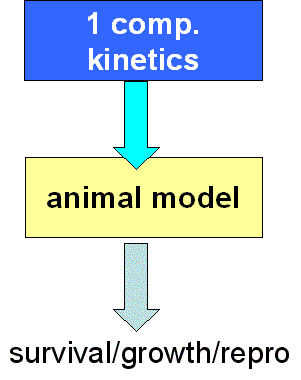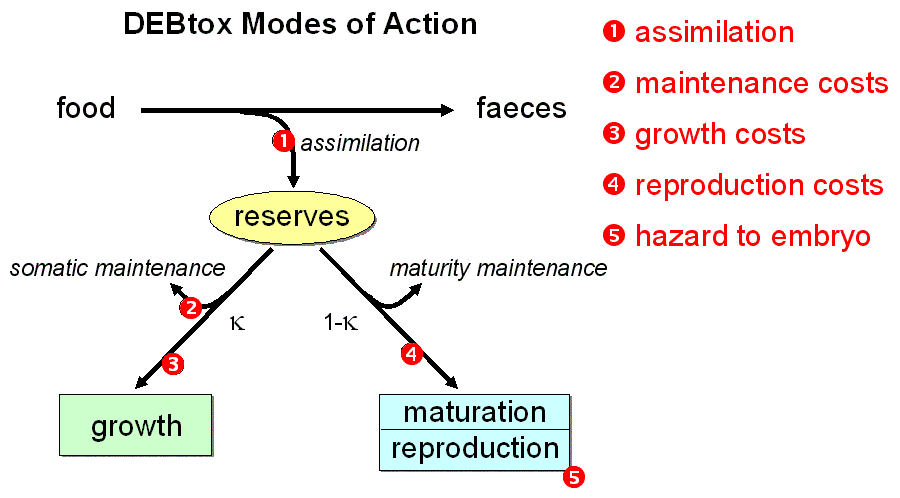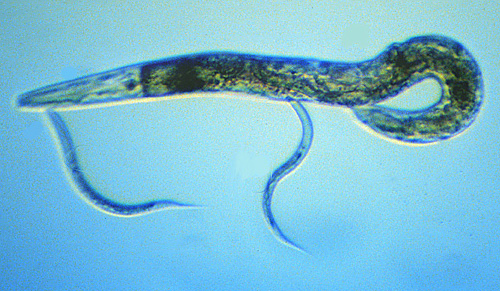Toxic effects on reproduction
Dr. D. T. Jager,
Prof. Dr. S. A. L. M. Kooijman ,
Chemical risk assessment attempts to protect the environment from the
potential adverse effects of chemicals. However, the only information
that is generally available are laboratory tests with single
species. The methods that are currently used to analyse data from
toxicity tests do not allow useful extrapolations to the population
level, because they focus on a single endpoint only (e.g. body size in
the standard fish growth test), and do not explicitly deal with
exposure time.
About DEBtox
The software protocol DEBtox
was developed to provide a process-based alternative for the analysis
of toxicity tests. Basic idea is the following:
- A chemical first needs to be taken up by the organism to exert a
toxic effect. The first step in the model chain is thus a
one-compartment accumulation model.
- Once inside the chemical influences the energy allocation of the
organism. Several modes of action are currently implemented.


Extending DEBtox
DEBtox focuses on the analysis of standard short-term tests. For a
proper understanding of the toxic mechanism of a compound, as well as
a translation to populations, life-cycle tests are required. In these
tests, the organisms are followed for a significant part of their life
cycle, scoring survival, growth and reproduction. This requires
several adaptations to DEBtox:
- The endpoints share common parameters (e.g. growth affects
reproduction). Therefore, the different endpoints must be analysed
together.
- Life-cycle tests run longer than standard test. Therefore, we
need to account for the effects of old age (senescence).
- The combined results for all endpoints can be used to calculate
population consequences. Because food limitation has predictable
effects within DEB context, effects at low food levels can be
explored.
Testing the extensions
 This project implements these adaptations, and tests them with
life-cycle experiments for nematodes (performed by the Dept. of Nematology at
the Wageningen University ). Nematodes are small roundworms, with
a relatively short life cycle. A further advantage of this group is
that it comprises species with diverse reproductive and feeding
strategies.
This project implements these adaptations, and tests them with
life-cycle experiments for nematodes (performed by the Dept. of Nematology at
the Wageningen University ). Nematodes are small roundworms, with
a relatively short life cycle. A further advantage of this group is
that it comprises species with diverse reproductive and feeding
strategies.
An example of a life-cycle analysis is shown below, for the nematode
Caenorhabditis elegans, exposed to the fungicide carbendazim. Green
points are the controls, red points are the results for the highest
exposure concentration. Carbendazim is assumed to work on the
assimilation of energy from food. All endpoints have been fitted
simultaneously.

 The intrinsic rate of population increase (according to the
Euler-Lotka equation) is shown in the other plot, with the predicted
effects at limiting food levels (as percentage of the
maximum). Clearly, the severity of the effects of carbendazim
increases with decreasing food availability.
The intrinsic rate of population increase (according to the
Euler-Lotka equation) is shown in the other plot, with the predicted
effects at limiting food levels (as percentage of the
maximum). Clearly, the severity of the effects of carbendazim
increases with decreasing food availability.
Posters presented
- 2003 SETAC conference in Hamburg, Germany
- 2005 SETAC conference in Lille, France
Go to projects' entry




 This project implements these adaptations, and tests them with
life-cycle experiments for nematodes (performed by the Dept. of Nematology at
the Wageningen University ). Nematodes are small roundworms, with
a relatively short life cycle. A further advantage of this group is
that it comprises species with diverse reproductive and feeding
strategies.
This project implements these adaptations, and tests them with
life-cycle experiments for nematodes (performed by the Dept. of Nematology at
the Wageningen University ). Nematodes are small roundworms, with
a relatively short life cycle. A further advantage of this group is
that it comprises species with diverse reproductive and feeding
strategies.

 The intrinsic rate of population increase (according to the
Euler-Lotka equation) is shown in the other plot, with the predicted
effects at limiting food levels (as percentage of the
maximum). Clearly, the severity of the effects of carbendazim
increases with decreasing food availability.
The intrinsic rate of population increase (according to the
Euler-Lotka equation) is shown in the other plot, with the predicted
effects at limiting food levels (as percentage of the
maximum). Clearly, the severity of the effects of carbendazim
increases with decreasing food availability.